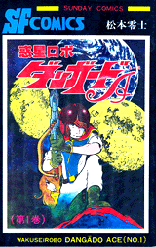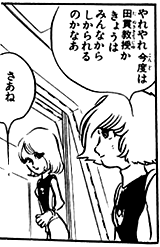1950s and '60s
Captain
Harlock's earliest appearance was as Captain Kingston in
'Adventures,' in 1956. Drawing on many and varied inspirations
(the wild west, warfare, space adventure, contemporary themes
and life in general), Matsumoto began the development of a
series of characters that would people his manga (and animated
derivatives) for the next fifty years. Variations on Harlock,
Tochirō, Tadashi Daiba, Emeraldas, Tori-san, Mii-Kun, Kei and
other characters would appear in many and diverse settings, from
the mountains of New Guinea, the jungles of the Pacific, the
depths of the Arctic ocean and the furthest reaches of space.
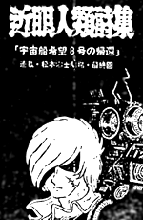
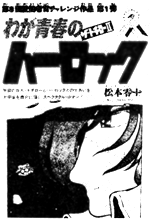
At times
Harlock would appear as himself, as in 'Waga Seishun no
Harlock' ('Harlock of my Youth,' above right), or in 'Daibā
Zero' ('Diver Zero') and 'Queen Emeraldas' (below), and at
other times in a completely different guise. However and
whenever he makes his appearance, Harlock is Matsumoto's greatest weapon in a
personal battle against all that is wrong, unjust and mundane
in this world, to be used as the author sees fit.

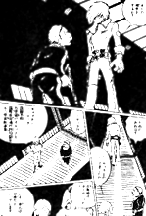

1974
Sutanrē no Majō [Stanley’s Witch]
Shonen Sunday Comics, 1974
Proto-Phantom F. Harlock makes a brief appearance in the first story of ‘Sutanrē no Majō,’ unsurprisingly flying a WWI-era bi-plane to Port Moresby (in Papua New Guinea) when he encounters the Witch of Stanley Mountain. In scenes that were later transposed into the opening of
the movie My Youth in Arcadia, this early Phantom is once more mocked by the witch, but he
seems to have survived the encounter as he leaves a book chronicling these events. Later on, during WW2, a
Tochirō look-alike and his compatriots discover the book, which is entitled,
of course, ‘Stanley’s Witch,’ and written, of course, by Phantom F. Harlock.
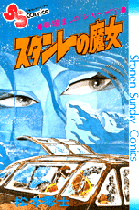
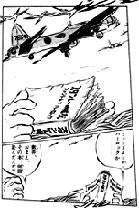
Interestingly, the ‘Revi C12D’ sight system (below) that the second Phantom F. Harlock was so attached to in
My Youth in Arcadia also shows up in ‘Sutanrē no Majō.’ This seems to have been the beginning of Matsumoto’s concept of the machine becoming part of the man, an integral part, which ultimately became, in
Space Pirate Captain Harlock and Ginga Tetsudō 999, the man becoming part of the machine.
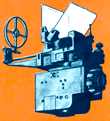
1975
Uchū Senkan Yamato [Space Battleship Yamato]
SF Comics, 1975
The mythos surrounding Harlock’s supposed appearance in Uchū Senkan Yamato is old and far reaching. The supposition is that Harlock was meant to be the elder brother of Susumu Kodai
(yes, the one that was found living in sin on Iskandar), who had disguised himself as the great pirate Harlock for reasons that remain obscure. Conversely, a twist on this story says that Harlock was meant to actually
be the elder Kodai brother in the initial story treatment, which would of course make
Harlock's surname ‘Kodai’... or... make Susumu’s last name ‘Harlock.’ Uh-huh.
Whoever Harlock was meant to be in this incarnation, or whoever was meant to be
Harlock, it is a fact that within the pages of volume one of the Yamato manga (and not in the anime), a ship looking much like the Deathshadow was encountered, it was flying the skull and crossbones, and a mysteriously shrouded figure
assumed to be Captain Harlock met with the Yamato crew. However the perpetrator of this masquerade has never been positively
identified.
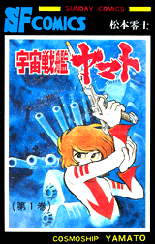
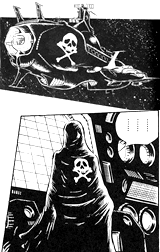
1976
Aurora no Kiba [Fang of Aurora]
Shonen Sunday Comics, 1976
In the title story from this collection of short works, a proto-Harlock commands a WW2 submarine that is forced into a hazardous battle beneath a field of icebergs. This proto-Harlock is accompanied by a Tadashi Daiba look-alike, who is ultimately the only survivor of the wreck of the
Aurora.
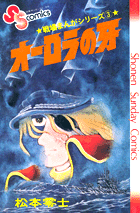
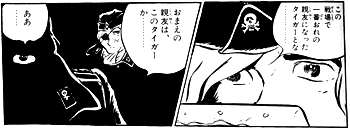
In another story in this volume entitled ‘Berurin no Kurokishi’ (Black Rider of Berlin), yet another proto-Harlock (minus his scars) loses an eye in a WW2 plane crash (he’s on the German side
again), adopts the skull and crossbones and lives to fight again.
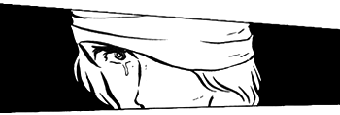


In a later story, ‘Zero,’ proto-Harlock (with scar) flies again in the Luftwaffe, and in yet another story an onigiri-eating young Harlock clone, along with a
Tochirō clone, flies into battle with a Zero squadron.
Waga Seishun no Arukadia
[My Youth in Arcadia | Arcadia of My Youth]
Shonen Sunday Comics, 1976
The manga ‘Waga Seishun no Arukadia’ overlaps with the feature film of the same name only marginally. The character Phantom F. Harlock makes
a 20th century appearance, though there is no connection made with the Space Pirate Harlock of the 2970s. In fact, as far as timelines go, the manga only makes it as far as 1976
(the same year it was published).
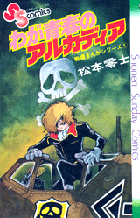
The title story of this anthology opens with a young Phantom F. Harlock flying his
Messerschmitt in WW2. The aircraft is emblazoned with the skull and crossbones, and the full name of the plane is
Waga Seishun no Arukadia Go. This section also includes the sighting mechanism ‘Revi
C12D’, which Harlock maintains here, as in the Arcadia movie, is his eyes, and his heart.
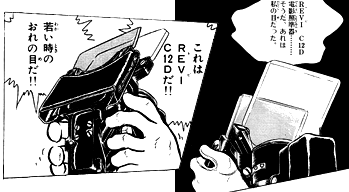
The story then fast-forwards 30-odd years (to 1976) and in true Matsumoto style we are left wondering just what happened over the last 30 years.
The year 1976, however, sees us in Heiligenstadt, Germany (the same place our
Space Pirate supposedly comes from), and an aged Phantom F. Harlock sits in the
rain. This unfortunate version of Harlock (the most unfortunate we will ever
encounter) has lost both his eyes and succumbed to a great depression.
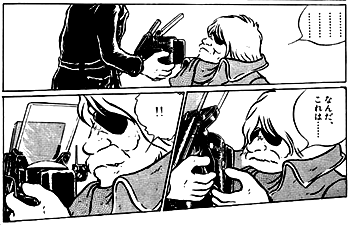

A mysterious stranger appears — who Harlock believes to be a certain ‘Daiba’, to whom he entrusted the Revi C12D during the war — who has come to return his ‘eyes’ to him. A terribly
poignant moment given that this Harlock no longer has eyes, and was blinded in the course of saving his good friend Daiba. Of course the mysterious stranger turns out to be a
Tochirō look-alike and the son of the original Daiba, and when he hands over the Revi C12D to Harlock we are shown, through flashback, the events of Phantom F. Harlock’s glory days and the
circumstances leading to the loss of his remaining good eye. ‘Waga Seishun no Arukadia’ is a moving story about friendship, loss and sacrifice, and ends with the hopelessly bereft Harlock and the young Daiba (and the reader, I might add) in tears.

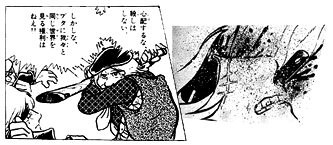

1977
Hotaru no Naku Shima [Weeping Firefly Island]
Hard Comics, December 1977
The scariest and nakedest Harlock incarnation appears in the short story ‘Saraba Roman no Toki yo,’ contained in the volume ‘Hotaru no Naku Shima.’ The ‘roman’ of the title
does not designate hairy men in sandals, but is the Japanised version of the English ‘romantic,’ and is used here in the truest sense of the word, which is defined as ‘pertaining to the heroic,’ or designating stories far
removed from everyday life. ‘Romance’ once upon a time was used to indicate passion, emotion and imagination, and when Matsumoto uses it, it also comes with a slight hint of wistfulness or nostalgia. ‘Saraba Roman no Toki yo’ translates as ‘Goodbye Romantic Times,’ but the emotion behind the title, and the nuances of the language, signify a more heartfelt goodbye to those days of dreams
and youth and passion.
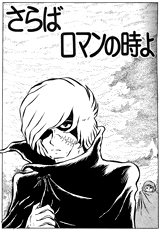
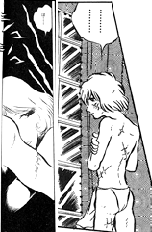
The proto-Harlock here goes by the name ‘Akeno,’ but plainly possesses the hairstyle, scar, eyepatch and cape of Harlock. Horrifyingly (to those of us who might view Harlock as the ultimate untouchable), he engages in sexual activity and lounges about his house (most shamefully in front of guests)
wearing nothing but a traditional loincloth. In this story a proto-Tochirō also appears, along with early versions of the handguns that later become so important to the Harlock-Tochirō mythos.
Dangādo A [Danguard Ace]
SF Comics, 1977
Another space drama, 'Danguard Ace' contains all the Matsumoto elements we’ve become familiar with. The squiggly figures, precise tech-art and the ink-heavy blackness of space. While it contains a number of cloaked figures, no proto-Harlock makes his appearance here, but a proto-Daiba, a proto-Kei Yuki, and even proto-Arcadia uniforms do make their appearances. ‘Danguard Ace’ is strongly reminiscent of
'Space Cruiser Yamato' in style, if any Yamato fans out there feel like looking it up.
